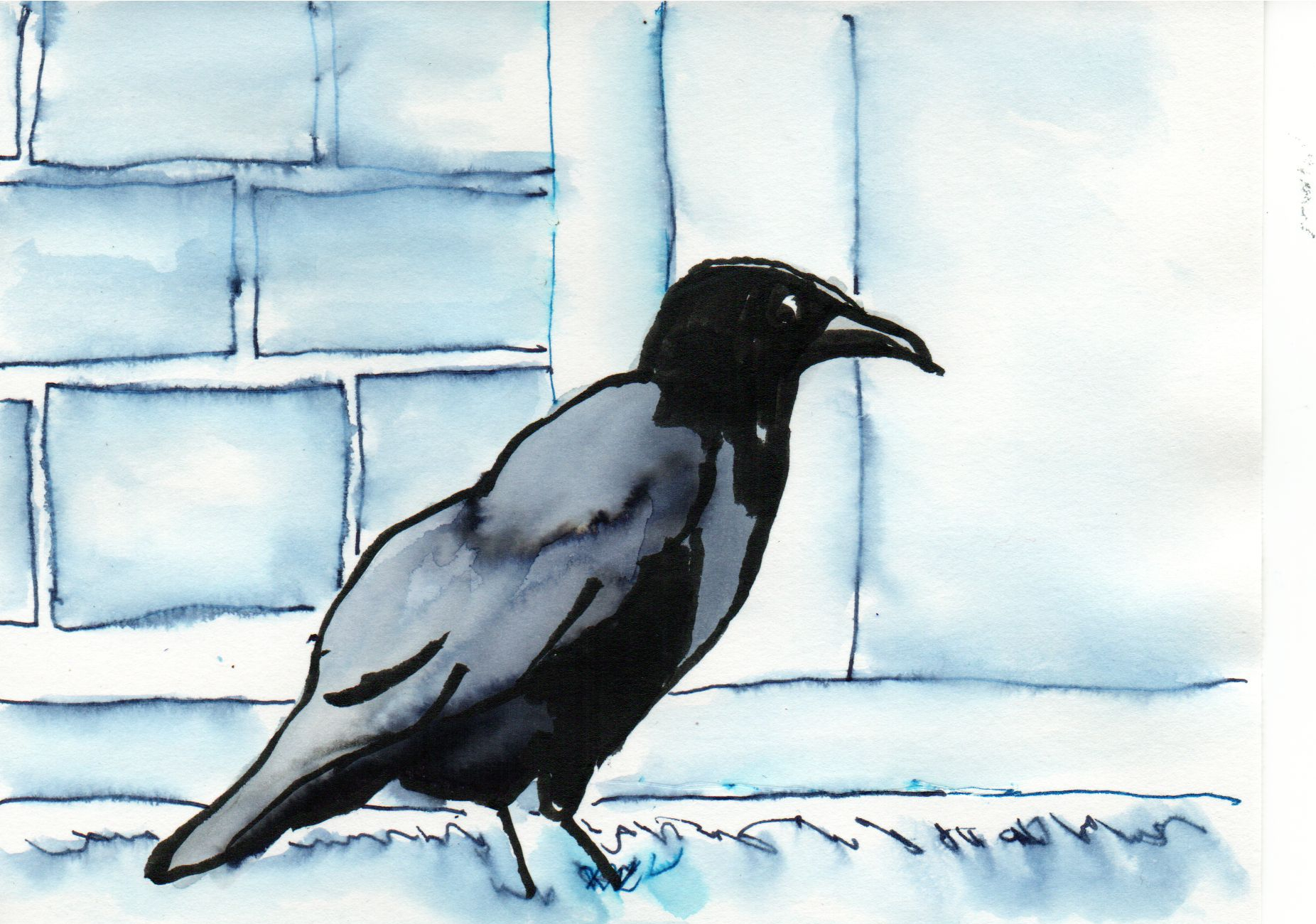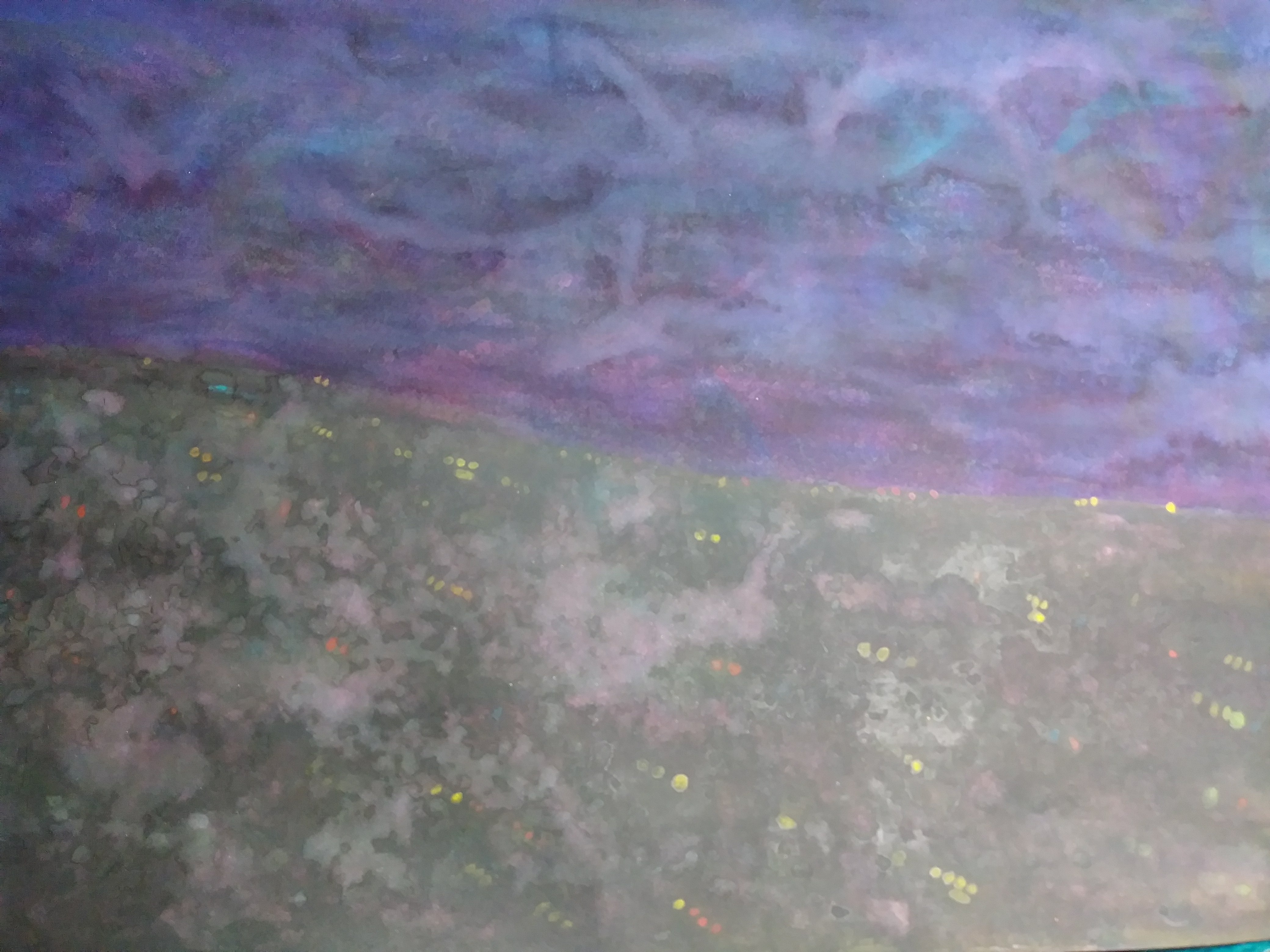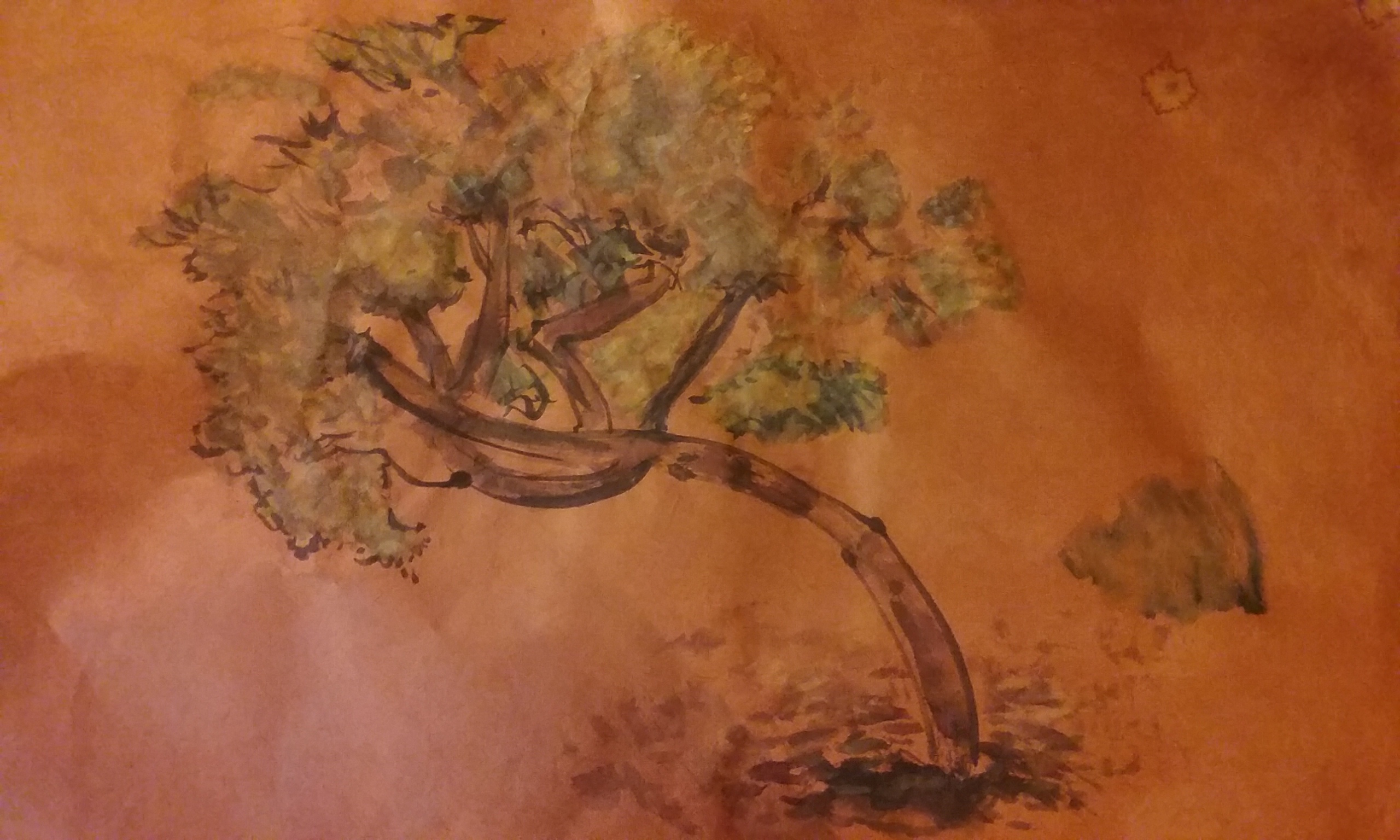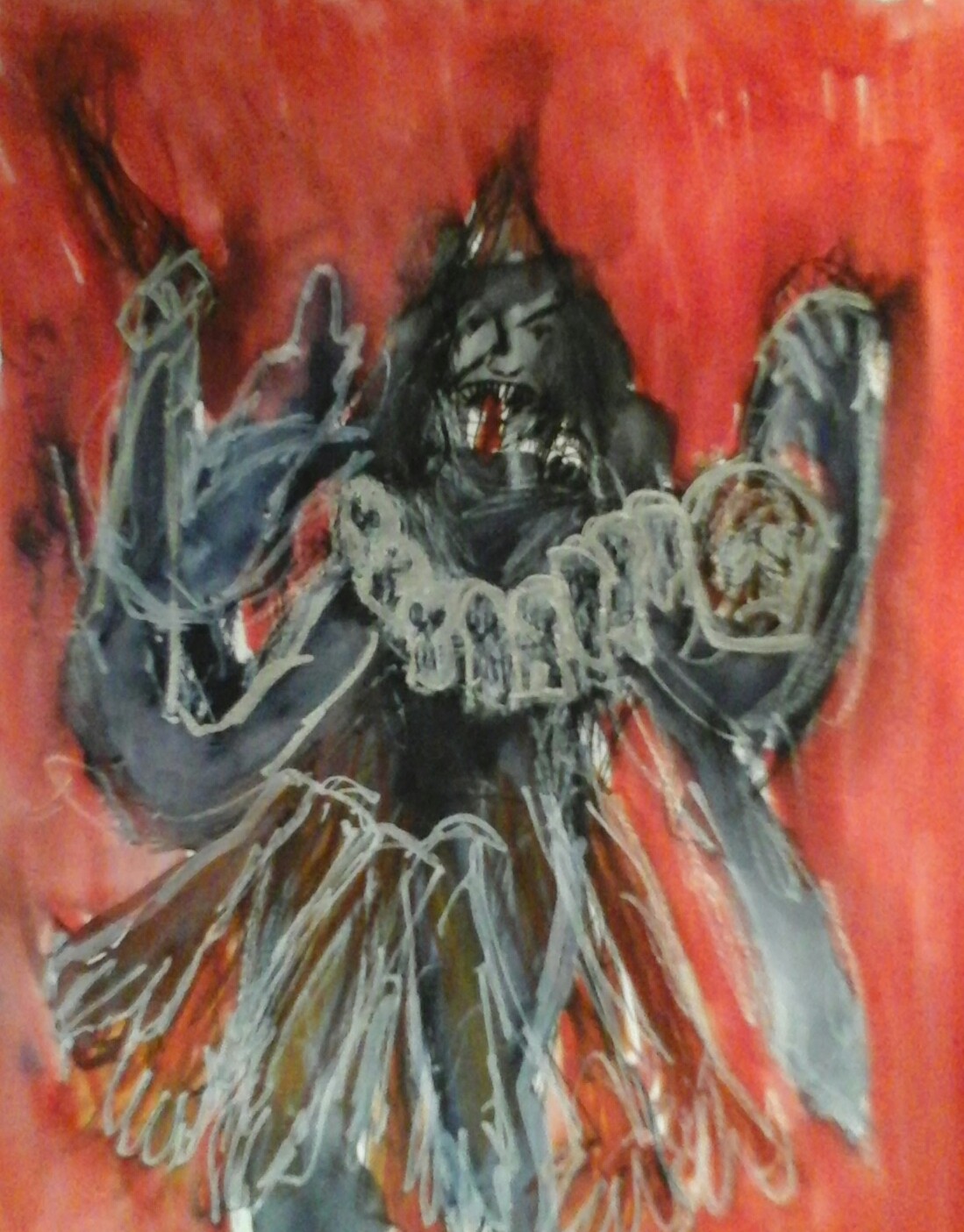
Our Neighbor



“Rolled in the midst of never-ceasing currents flowing without rest forever onward.” Rig Veda1,32,10.
Halloween is coming, and with it, Samhain, the ancient, pagan holiday from which it is derived. Samhain is the Celtics holiday which marks the coming of winter and the death of the deciduous plant life for the year. By extention, it also memorializes all the life that has past that year. This passing from the life of Spring and Summer to the death of Fall and Winter is where the idea of Ghosts and Otherworld creatures roaming our world comes from.
The Goddess of the ancient Celts is called Danu. You will be told that this Goddess is specific to the Irish Celts, but the river Danube which runs through Germany is named for her as well. There is another water Goddess even farther from Ireland named Danu. In India. While researching Danu, for a painting this Halloween I found mention of her, and the belief by some that they are the same Goddess. I found that the Indian version of Danu, which is in the Rig Veda, has been demonized just as the European one has. In India she is the mother of Vitra the dragon, who is defeated by indra. Finding out she’s a dragon only makes me like her even more. Here is an abstract painting of her, rendered in ink in honor of Inktober.

I’ve been working on this for a few days and I think it’s getting close. Either that or I’m going to start over lol. I wanted to do a big kali Night painting on watercolor paper with watercolors. I’ve been doing them small in ink on a really absorbant paper from the Himalayas, which is culturally poetic, but I wanted to see what I could do with a medium I have more experience with after learning on a less forgiving media. Turns out I face many of the same difficulties.
Having said that, it is nice to really wade into watercolors again. There’s a much more alchemical feel to them, because the colors interact with each other differently. With inks they’re all just basically dyes. At least the ones I was using, anyway.
Let me know what you think.
I’ve been getting into a lot of musical biographies lately. It’s really inspiring to hear the creative journey of people like George Harrison and John Coltrane; their musical genius is wrapped up in spiritual expression. I identify with that quite a bit.
From the microscopic atom, with its orbiting electrons, to our planet rotating on its axis, which orbits the star we call the Sun, which also spins and orbits the galaxy, which itself rotates around its center, everything is spinning and swirling in a circular motion. It’s fascinating to me that electricity is generated this way as well. Is this why dervishes whirl? I think it is Probable, even though the method was developed in the thirteenth century by Rumi himself. (if Rumi had taken up Asian style calligraphy, he would have been Rumi the sumi sufi.)
This piece is part of a series and was done with acrylic, ink, and digital media. Buy the shirt here.

I have been wanting to paint a large scale sumi painting. For me this means about 20×30 inches. I know there are much larger paintings, but I have been doing 5×7 ones. The handmade paper I get comes in 20×30 & I’ve been cutting down to make folios for my sketchbook. You use a whole different set of muscles when you work larger scale. This is my first one. It’s a tree on the property of my apartment complex and I think it lends itself nicely to the project. I did a sketch first because the materials can be costly working large, if you have to throw away a bunch of mistakes. I don’t normally make preliminary sketches, primarily because I’m so lazy, but in this instance I wanted to get a feel for for how things might play out. It was helpful for composition and knowing which brushes would be useful and other procedural processes.
Legitimate problems with too much preliminary work is that it can reduce the improvisational surprises that can keep your work lively. Also, if your sketch comes out better than your actual work, it can be a drag, because usually it’s done with cheap paper and materials. But, many people do sketches of different angles, compositions, color comps, and really like to lock down all the details before rendering the final piece. I tend to work out a lot of that with my reference photos. I generally take all my own references, and since the advent of digital photography, there’s no reason not to experiment at this level. It’s important to get lighting, angles and composition just right in reference photos so your final piece has as much worked out in advance as possible. This way, my drawing can be loose on the final and keep as much energy as possible. There’s a saying that if you’re not enjoying it, you audience won’t enjoy it. If you’re not surprised, and interested by your work, your audience won’t be either.
The sumi style requires painting without an under drawing on your paper, so that’s why doing a separate preliminary painting can be helpful.
I may work on the final more. I had to stop because my children woke up from their naps. One of the challenges was getting a light touch on the delicate foliage using ink on absorbant paper, so there is a light look that may be too light. Also, working large requires photographing the piece rather than scanning it.
Here is my 1st attempt at a traditional sumi Dragon. I’ve done sumi Dragons before, but those were done in a kind of one stroke method that I thought best utilized the energy channeling zen technique of Hitsuzendō. When I first started translating Hitsuzendō from calligraphy to painting, I hadn’t realized the breadth of the sumi style. I was trying to do calligraphy in picture form. I still really like the way that kind of image comes out, but I’m trying to to be more true to the sumi heritage while also learning to apply it to my more traditionally Western style of painting. That is a total contradiction I know, but luckily Taoism and tàijítú allow for, and indeed rely on contradictions.
This image is really tiny; and I realized I’d like to do this kind of thing on a large scale, so I have to figure out how to make that happen. The problem with that is, this kind of technique doesn’t lend itself to corrections, and materials can be expensive on a large scale, so I’m going to need some practice.
I made this piece for my son, Gabriel, who is obsessed with the moon. Originally, I had planned on making it more detailed, but I really like the energy of this direct and simple execution. I am experimenting with this zen style of painting. The idea of the style is to empty your mind and let the energy of your spirit flow into the painting. When executing a Kanji calligraphy, the calligrapher would concentrate on the word or phrase and Chanel the energy of that into the calligraphy. When I do Sanskrit Calligraphy that’s what I do. It’s kind of a learning curve. I get a small brush and practice the word over and over until I’m comfortable with it. Even if it’s a word I know really well. Then I prepare several sheets of paper and execute the word full size several times. Sometimes I do several full size practices 1st, but if I have enough good paper, I just go for it, because sometimes the best one is what you thought was a practice one, and if you did it on practice paper, you’re screwed. At the end of the session, I’m exhausted and maybe have one or two good pieces. Maybe none came out good enough. It’s hard to tell because the aesthetic is different from traditional calligraphy. It has to have a vibe to it. It should also be relatively centered on the page and not have any glaring mistakes or drips.
A scene involving multiple subjects and composition and thought about meaning, mood, color, brushes, inks, requires too much mental activity to do it all in advance and then just execute a plan, like a well rehearsed dance. Spontaneity is a big part of of these pieces. It’s not Bach, it’s the blues. Pieces like the sumi moons on blue paper, are fairly spontaneous; I’ve painted similar scenes enough to not have to plan it out too much to get the right feel. Still the process of emptying my mind is the new element that has to fit into the puzzle. It’s difficult to do it for a prolonged period of time.
For this piece, I thought I would start with this simple moon/sky. First I did it in black; a series of enso circles to define the moon and the surrounding sky, then broader with water, to create a wash. Then back in with gold for the moon and a halo, and then blue violet for the sky, using the same technique. For each stroke, I empty my mind, breath out, breath in and then execute the stroke on the exhale, driving the energy through my body and down my arm and into the painting with each stroke. Then I had planned to go back and add detail to the moon, perhaps a ground beneath, maybe the ocean. Maybe add clouds, or stars. However, I was struck by the energy in the underpainting, and I thought further detail would weaken what seemed to me to be a strong piece. It’s for my son anyway, and not really for sale, so it doesn’t matter if it’s polished or not. He’s two years old. Almost three. But it was a real learning experience. To reset after each stroke, concentrate on what I am doing and not what I did or what I am going to do. This is the goal of this kind of technique. It’s a meditation practice for monks. Hopefully, I can keep this lesson learned.
A print of this piece can be purchased here.

Bless Christine Blasey Ford. May she speak with clarity strength. May no one stand in her way. Give her strength and confidence, courage and willpower. May her ferocity be that of Kali Ma, that none may oppose her.
I’m updating this post to include paintings of Kali incarnated as her traditional Goddess, replete with blue skin, lolling tongue, necklace of skulls and skirt of arms. These frightening accouterments strike fear into the hearts of those who are not familiar with her. But her devotees know that she destroys that which keep them from obtaining enlightenment.
For my series of paintings, “Kali Night,” I have chosen as my subject matter, a stormy night. My inspiration comes from driving home from work one evening and seeing the sky lit up eerily beautiful and ominous. I was reminded of the Goddess Kali, who is a paradox of beauty, compassion, violence, love and is ultimately nearly as incomprehensible as the ultimate reality she represents. She has been worshipped for longer than recorded history, which is fitting since one interpretation of her name is “beyond time.”

Kali is misunderstood in the west. Really she is the perfect boogeyman for Puritan Americans; She’s naked (being infinite and unfathomable makes it hard to find something in your size, besides, Kali is indifferent to human conventions), except for the skirt of human arms! (being pure energy, Kali/Shakti is the receiver of all action, these limbs represent those who have been liberated from karma) Also she is adorned by a necklace of skulls! (one for each letter of the Sanskrit alphabet. This is a very “Alpha & Omega symbol. Alphabets contain the seeds of everything that can be expressed, thus attributing to God all that exists. Also, it is the beginning and the end of everything, thus skulls are appropriate.)
Kali is really a compassionate mother whose fearsomeness represents the way in which she destroys evil and all that stands in the way of her devotee’s liberation from the bondage of self.
I choose a stormy night to represent Kali as a metaphor for her ominous and fearsome qualities as the Goddess is everywhere and the various experiences we have in life remind us of the myriad manifestations of the Goddess.

The tàijítú is the name of the symbol commonly known as “yin/yang.” It is a symbol for the complementary nature of opposites; night defines day, shadow defines light; an inhale isn’t complete without an exhale… All existence can be seen to utilize this seeming duality to for a unified whole.
Also, In non dualistic Shaivism of Kashmir, there is a tradition known as Spanda, which like the material of a similar name, expands & contracts. That is the the universe, like a beating heart, or a piece of metal that expands in the heat and contracts in the cold, or water which does the opposite. It’s very much a yin and yang view of reality.
These pieces are rendered using a zen technique that infuses them with chi (the “ji” in “tàijítú”). They are aproxamately 8×10 in size. They are rendered with gold, purple and sumi ink with a sumi brush on lokta paper; a paper made in the Himalayas from materials indigenous to that region.